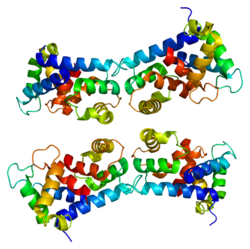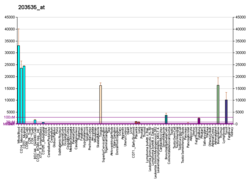Function
S100A9 is a member of the S100 family of proteins containing 2 EF hand calcium-binding motifs. S100 proteins are localized in the cytoplasm and/or nucleus of a wide range of cells, and involved in the regulation of a number of cellular processes such as cell cycle progression and differentiation. S100 genes include at least 13 members which are located as a cluster on chromosome 1q21. This protein may function in the inhibition of casein kinase. [5]
MRP14 complexes with MRP-8 (S100A8), another member of the S100 family of calcium-modulated proteins; together, MRP8 and MRP14 regulate myeloid cell function by binding to Toll-like receptor 4 (TLR4) [6] [7] and the receptor for advanced glycation end products. [8]
Intracellular S100A9 alters mitochondrial homeostasis within neutrophils. As a result, neutrophils lacking S100A9 produce higher levels of mitochondrial superoxide and undergo elevated levels of suicidal NETosis in response to bacterial pathogens. [9] Furthermore, S100A9-deficient mice are protected from systemic Staphylococcus aureus infections with lower bacterial burdens in the heart, which suggests an organ-specific function for S100A9. [9] [10]
Clinical significance
Altered expression of the S100A9 protein is associated with the disease cystic fibrosis. [5]
MRP-8/14 broadly regulates vascular inflammation and contributes to the biological response to vascular injury by promoting leukocyte recruitment. [11]
MRP-8/14 also regulates vascular insults by controlling neutrophil and macrophage accumulation, macrophage cytokine production, and SMC proliferation. The above study has shown therefore the deficiency of MRP-8 and MRP-14 reduces neutrophil- and monocyte-dependent vascular inflammation and attenuates the severity of diverse vascular injury responses in vivo. MRP-8/14 may be a useful biomarker of platelet and inflammatory disease activity in atherothrombosis and may serve as a novel target for therapeutic intervention. [12] Also, the platelet transcriptome reveals quantitative differences between acute and stable coronary artery disease. MRP-14 expression increases before ST-segment-elevation myocardial infarction, (STEMI), and increasing plasma concentrations of MRP-8/14 among healthy individuals predict the risk of future cardiovascular events. [13]
S100A9 (myeloid-related protein 14, MRP 14 or calgranulin B) has been implicated in the abnormal differentiation of myeloid cells in the stroma of cancer, and to leukemia progression. [14] [15] This contributes to creating an overall immunosuppressive microenvironment that may contribute to the inability of a protective or therapeutic cellular immune response to be generated by the tumor-bearing host. In myelofibrosis, S100A9/S100A8 have been shown to be expressed by macrophages and to activate stromal cells via TLR4 [16] [17] . The use of Tasquinomod, a group targeting S100A9, is currently under clinical trial for myelofibrosis patients.
Outside of malignancy, S100A9 in association with its dimerization partner, S100A8 (MRP8 or calgranulin A) signals for lymphocyte recruitment in sites of inflammation. [18] S100A9/A8 (synonyma: Calgranulin A/B; Calprotectin) are also regarded as marker proteins for a number of inflammatory diseases in humans, especially in rheumatoid arthritis and inflammatory bowel disease (IBD).
Myeloid-related protein (MRP)-8 is an inflammatory protein found in several mucosal secretions. In cervico-vaginal secretions MRP-8 can stimulate HIV production; [19] and thus might be involved in sexual transmission of HIV, as well as other sexually transmitted diseases (STD). In Vitro studies have shown that HIV-inducing of recombinant MRP-8 can increase HIV expression by up to 40-fold. [19]
This page is based on this
Wikipedia article Text is available under the
CC BY-SA 4.0 license; additional terms may apply.
Images, videos and audio are available under their respective licenses.







